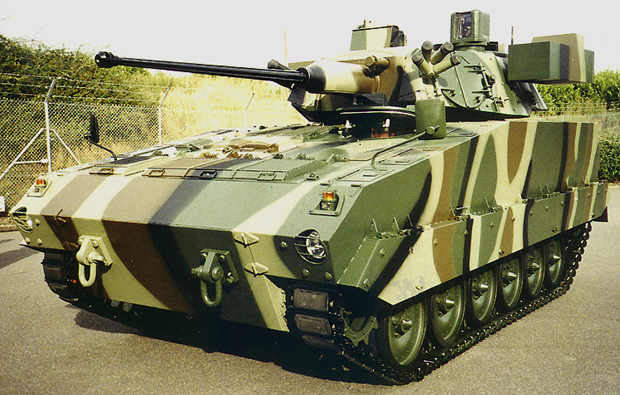Stormer 30, first launched in 1997, is a highly mobile armoured reconnaissance vehicle and light tank developed by Alvis Vickers Ltd (now BAE Systems Land Systems) of Coventry, UK.
Stormer 30 is a variant of the Stormer family of tracked vehicles and the development was based on proven technology from the Scorpion range of light tanks for operation on any terrain and in any environment. The vehicle is operated by three crew members, a driver, a commander / loader and a gunner.
The vehicles were trialed and demonstrated in the UK and in the Middle East.
Stormer 30 light tank mission roles
The Stormer 30 fulfils a variety of military and peacekeeping functions, providing reconnaissance, fire support, escort duties, armour in advance and withdrawal, and support within internal security roles.
The fully stabilised HITFIST turret is supplied by Oto Melara and has 30mm cannon and twin TOW missile system providing the capability to fire on the move. The vehicle has tank killing capability and the cannon can defeat light armoured vehicles (LAV) fitted with the highest levels of protection.
Stormer 30 can be lifted by a CH-53 helicopter and will fit into a C-130 transport aircraft. It can be moved by commercial truck, on rail flatbed rolling stock or by an amphibious landing ship.
Storm 30 armament
The main armament of the Stormer 30 is the ATK Ammunition Systems (formerly Boeing Ordnance) Bushmaster II 30mm automatic cannon. The cannon and turret can traverse through 360° and the elevation is from -45° to +60°.
The cannon’s rate of fire is from a single shot to a maximum of 200 rounds per minute. The cannon has a double selection ammunition feed system with 180 rounds of ammunition ready to fire.
Stormer 30 is equipped with two 7.62mm general purpose machine guns with a range of 400m. The machine gun mounted coaxially with the main armament has 700 rounds of ready-to-fire ammunition.
Two multi-barrel grenade launchers installed on the front of the turret provide 180° coverage over the forward arc. The launchers, operating on the 24V electrical supply, are each armed with four smoke grenades.
The installation of the TOW missile launcher on either side of the turret is optional on the Stormer 30. The traverse of the missile launcher is the continuous 360° traverse of the turret and the elevation range is -7.5° to +30°.
The TOW missile is produced by Raytheon Missile Systems Company and is manufactured under licence in the UK by MBDA (formerly Matra BAe Dynamics). Versions of the missile have been developed with a high explosive 6in diameter shaped charge and also with a tandem shaped warhead designed for improved hull penetration. Two missiles are carried in the launch tubes and two spare missiles are carried inside the vehicle.
Self-protection
The Stormer 30 is manufactured with an armoured aluminium hull with spaced high hardness steel armour and spall liner, which provides protection against 14.5mm heavy machine guns, mines and artillery shell splinters.
Fire control and surveillance
The sighting and vision systems are fitted according to the customer country’s mission requirements. The commander’s station is fitted with an optional panoramic sight and six episcopes fitted with a switch for gun and episcope alignment. The gunner’s station is equipped with a day and night sight.
Propulsion
The Stormer 30 engine is the 5.88l, six cylinder 6B-275 supplied by Cummins, which provides 187kW at 2,600rpm.
The transmission system is the T303 cross drive automatic transmission system.
The vehicle has an 80km per hour maximum speed on a level tarmac road in both forward and reverse. The vehicle accelerates from 0 to 50km per hour in 20 seconds and from 50 to 65km per hour in 20 seconds. The fording depth is 1m. The maximum gradient for stopping and restarting is 60%.
Mobility of the Stormer 30
The Stormer 30 is fitted with torsion bar type suspension featuring six dual rubber tyre wheels. The drive sprocket is provided at the front and idler at the rear end.
The first, second and sixth road wheel stations are equipped with lever-controlled rotary dampers. Two track-return rollers and the upper side of the track are shrouded by a light steel cover to reduce dust.










